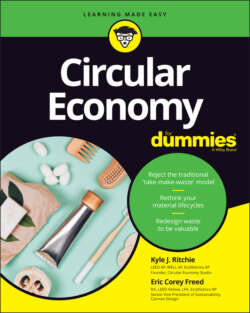Читать книгу Circular Economy For Dummies - Eric Corey Freed - Страница 93
Waste = Food: Redefining Disposal
ОглавлениеWe have only one planet to work with. Despite its being a relatively big planet compared to the size of human beings, we still have only one planet — and just one set of resources. In this world of limited resources, it’s becoming more and more apparent that the way we manage these resources needs to change in order for us to continue to support the demands of the global population. As populations continue to rise, so does the negative impact we humans have on the world around us. Although we have gotten better at increasing our efficiency in many sectors — energy, for example — the reality is that the global economy is still extremely inefficient and has an end date if a transformation doesn’t occur soon. For us to continue to sustain our lives, our waste needs to be seen as a valuable resource rather than a discarded item.
The global economy has done a decent job of developing more efficient methods, but within specific areas, not across different areas. Take a production of a bottle of Coke and the shipping materials required to deliver that bottle of Coke to retailers. The manufacturers of Coca-Cola have surely scaled their production processes efficiently to maximize their returns while minimizing their losses. As for shipping these products, they have surely determined the optimal level of packaging required to deliver these bottles unscathed to their retailers. However, the right questions haven’t been asked about the connection between these two elements of the lifecycle. Is there a kill-two-birds-with-one-stone opportunity here? Of course there is! A large percentage of Coca-Cola is composed of water. Water is readily available in every household, in private buildings as well as public ones. So why not eliminate water from the recipe initially and simply have the consumer add it themselves? Doing so would reduce the costs of producing Coca-Cola and would greatly reduce the amount of packaging required to deliver the product to the customer.
Once waste is eliminated by transitioning from a linear economy to a circular economy, the demand for raw materials will drop dramatically and the value of materials existing within the circular lifecycle will increase because of the lack of replacement costs required. For example, Desso, a company that produces an array of carpets and artificial turfs, is already discovering the waste reduction and value associated with alternative business strategies. Through a combination of designing materials to be fully recyclable and managing to lease out certain products, it has invested in generating longer-lasting products and harvesting the resulting value.
It’s critical for the concept of waste to be reconsidered within our global operations. Waste as an idea is flawed from the beginning, by assuming that it needs to exist. Every piece of packaging can be reused. Every amount of water can be utilized for another purpose. Every piece of organic waste that stems from agriculture can be returned to the fields to act as a fuel source for next year’s harvest. Ultimately, harnessing the power of the circular economy isn’t about using as little of a resource as possible. Instead, it’s about developing efficient systems that don’t care how much of something you use, because, at the end of the day, it won’t go to waste. Creating this reality will require that we humans change the way we view and manage what we consider waste and adjust our processes to identify and utilize its potential value.
Accepting this idea that waste doesn’t exist isn’t just a concept that should be limited to business operations. To account for the complexity of the global economy, this type of circular thinking should be addressed in every sector of a product’s lifecycle. Customers, governments, suppliers, and communities should all be included. If customers demand that a product be made with 100 percent recycled materials, then the suppliers, manufacturers, and business entities involved will be forced to address their demand within their operations. This future idea of all companies operating within a circular fashion (by the way, check out Chapter 18 — our chapter on the fashion industry) isn’t so far off into the future. Companies that are tackling this task early on will be better positioned to compete against other companies that take on this initiative when the circular economy is no longer optional, but mandatory.
